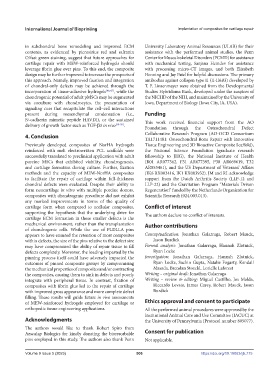Page 514 - IJB-9-5
P. 514
International Journal of Bioprinting Implantation of composites for cartilage repair
in subchondral bone remodeling and improved ECM University Laboratory Animal Resources (ULAR) for their
contents, as evidenced by picrosirius red and safranin assistance with the performed animal studies, the Penn
O/fast green staining, suggest that future approaches for Center for Musculoskeletal Disorders (PCMD) for assistance
cartilage repair with MEW-reinforced hydrogels should with mechanical testing, Sanjana Hemdev for assistance
leverage fibrin glue over pins. To this end, the composite with processing micro-CT images, and both Elizabeth
design may be further improved to increase the prospects of Henning and Jay Patel for helpful discussions. The primary
this approach. Namely, improved fixation and integration antibodies against collagen type II (II-II6B3) developed by
of chondral-only defects may be achieved through the T. F. Linsenmayer were obtained from the Developmental
incorporation of tissue-adhesive hydrogels [46,47] , while the Studies Hybridoma Bank, developed under the auspices of
chondrogenic potential of adult pMSCs may be augmented the NICHD of the NIH, and maintained by the University of
via coculture with chondrocytes, the presentation of Iowa, Department of Biology (Iowa City, IA, USA).
signaling cues that recapitulate the cell–cell interactions
present during mesenchymal condensation (i.e., Funding
N-cadherin mimetic peptide HAVDI), or the sustained This work received financial support from the AO
delivery of growth factor such as TGF-b3 in vivo [48-50] . Foundation through the Osteochondral Defect
4. Conclusion Collaborative Research Program (AO-OCD Consortium
TA1711481: Osteochondral Bone Repair with Innovative
Previously developed composites of NorHA hydrogels Tissue Engineering and 3D Bioactive Composite Scaffold),
reinforced with melt electrowritten PCL scaffolds were the National Science Foundation (graduate research
successfully translated to preclinical application with adult fellowship to JHG), the National Institute of Health
porcine MSCs that exhibited viability, chondrogenesis, (R01 AR077362, F31 AR077395, P30 AR069619, T32
and cartilage formation during culture. Further, fixation AR053461), and the US Department of Veterans’ Affairs
methods and the capacity of MEW-NorHA composites (IK6 RX003416, IK1 RX003932). JM and RL acknowledge
to facilitate the repair of cartilage within full-thickness support from the Dutch Arthritis Society (LLP-12 and
chondral defects were evaluated. Despite their ability to LLP-22) and the Gravitation Program “Materials Driven
form neocartilage in vitro with multiple porcine donors, Regeneration” funded by the Netherlands Organization for
composites with chondrogenic preculture did not exhibit Scientific Research (024.003.013).
any marked improvements in terms of the quality of
cartilage form when compared to acellular composites, Conflict of interest
supporting the hypothesis that the underlying drive for The authors declare no conflict of interests.
cartilage ECM formation in these smaller defects is the
mechanical environment, rather than the transplantation Author contributions
of chondrogenic cells. While the use of PLDLLA pins
appears to have ensured the retention of most composites Conceptualization: Jonathan Galarraga, Robert Mauck,
within defects, the size of the pins relative to the defect size Jason Burdick
may have compromised the ability of repair tissue to fill Formal analysis: Jonathan Galarraga, Hannah Zlotnick,
defects completely. Moreover, the loading imparted by the Ryan Locke
pinning process itself could have adversely impacted the Investigation: Jonathan Galarraga, Hannah Zlotnick,
outcomes of pinned composite groups by compromising Ryan Locke, Sachin Gupta, Natalie Fogarty, Kendall
the mechanical properties of composites and/or contracting Masada, Brendan Stoeckl, Lorielle Laforest
the composites, causing them to sink in defects and poorly Writing – original draft: Jonathan Galarraga
integrate with peripheral tissue. In contrast, fixation of Writing – review & editing: Miguel Castilho, Jos Malda,
composites with fibrin glue led to the repair of cartilage Riccardo Levato, James Carey, Robert Mauck, Jason
with improved gross appearance and more complete defect Burdick
filling. These results will guide future in vivo assessments
of MEW-reinforced hydrogels employed for cartilage or Ethics approval and consent to participate
orthopedic tissue engineering applications. All the performed animal procedures were approved by the
Institutional Animal Care and Use Committee (IACUC) at
Acknowledgments the University of Pennsylvania (Protocol number 805077).
The authors would like to thank Robert Spiro from
Aesculap Biologics for kindly donating the bioresorbable Consent for publication
pins employed in this study. The authors also thank Penn Not applicable.
Volume 9 Issue 5 (2023) 506 https://doi.org/10.18063/ijb.775

